
This 1-Ingredient Gluten-Free Buckwheat Bread recipe is an absolute game-changer! I’ve been making it every single week since early 2022, and it never disappoints! It’s incredibly easy, delicious, and super nourishing. I highly recommend throwing a couple of slices in the toaster/oven to create the ultimate avocado toast or as a side dish for dipping into soup. It even makes amazing croutons in a salad!
Since sharing this recipe with our community on social media, it’s become one of our most popular recipes to date. Hundreds of our community members have shared their versions with us on Instagram. Check out our Buckwheat Bread Instagram Highlights to see just a sample of the ones we’ve received, and please make sure to share your own! If you’re in interested in more gluten-free bread recipes, you’ll also love this super fluffy Red Lentil Quinoa Bread!

Ingredient Notes
- Hulled Raw Buckwheat: Buckwheat groats (or kernels) are the hulled seeds of the buckwheat plant. Despite their name containing the word “wheat,” buckwheat is actually gluten-free and makes for a fantastic bread ingredient. These groats are a staple in many Eastern European and Asian cuisines, known for their nutty flavor and versatile use. This Healthy Buckwheat Bread Recipe is a testament to that.
- Water: Tap water is fine to use depending on your location, if the water is heavily chlorinated in your area, you should choose filtered water, as chlorine will impact the fermentation.
- Salt: Either sea salt flakes or table salt works fine. The salt enhances the natural flavor of the buckwheat.
- Poppy and Sesame Seeds: Adds a delightful crunch and visual appeal to the bread. They are optional but highly recommended for an extra touch of flavor and texture. You can top it with any seeds you like.
IMPORTANT: Use ONLY hulled, non-roasted buckwheat for this recipe. Buckwheat flour, unhulled buckwheat, activated buckwheat, or roasted buckwheat will not work in this recipe.
Why You’ll Love This 1-Ingredient Buckwheat Bread Recipe
- Delicious and Dense: It’s absolutely delicious, with a dense, satisfying texture, and gets even better when toasted! Fermentation not only enhances the flavor, but it can improve the bioavailability of certain nutrients in foods. Specifically, the fermentation process can reduce levels of phytic acid, which is known to bind some minerals and reduce their absorption. By breaking down phytic acid, fermentation can make minerals like iron, zinc, and magnesium more available for absorption by the body.
- So Easy: Although the fermentation process takes a bit of time, this recipe is very hands-off and only requires about 10 minutes of actual work. If you use the right kind of buckwheat, a high-speed blender, and follow the instructions, this simple, yeast-free bread recipe is practically foolproof.
- Cost-effective: Good quality, nourishing, gluten-free bread can be quite expensive where we live, often costing around $15 AUD (~ $9.80 USD), whereas this Gluten-Free Buckwheat Bread comes in at under $3.50 AUD (~ $2.30 USD), even when using organic hulled buckwheat.
- Meal-Prep: Easy to prep in advance and can be frozen. I usually keep half fresh, wrapped in a clean kitchen cloth, to consume in the next few days and slice and freeze the rest. Toast when ready to eat, and it’s as good as fresh! This way, you can toast a piece whenever you crave some delicious bread.
What Are the Health Benefits of Buckwheat?
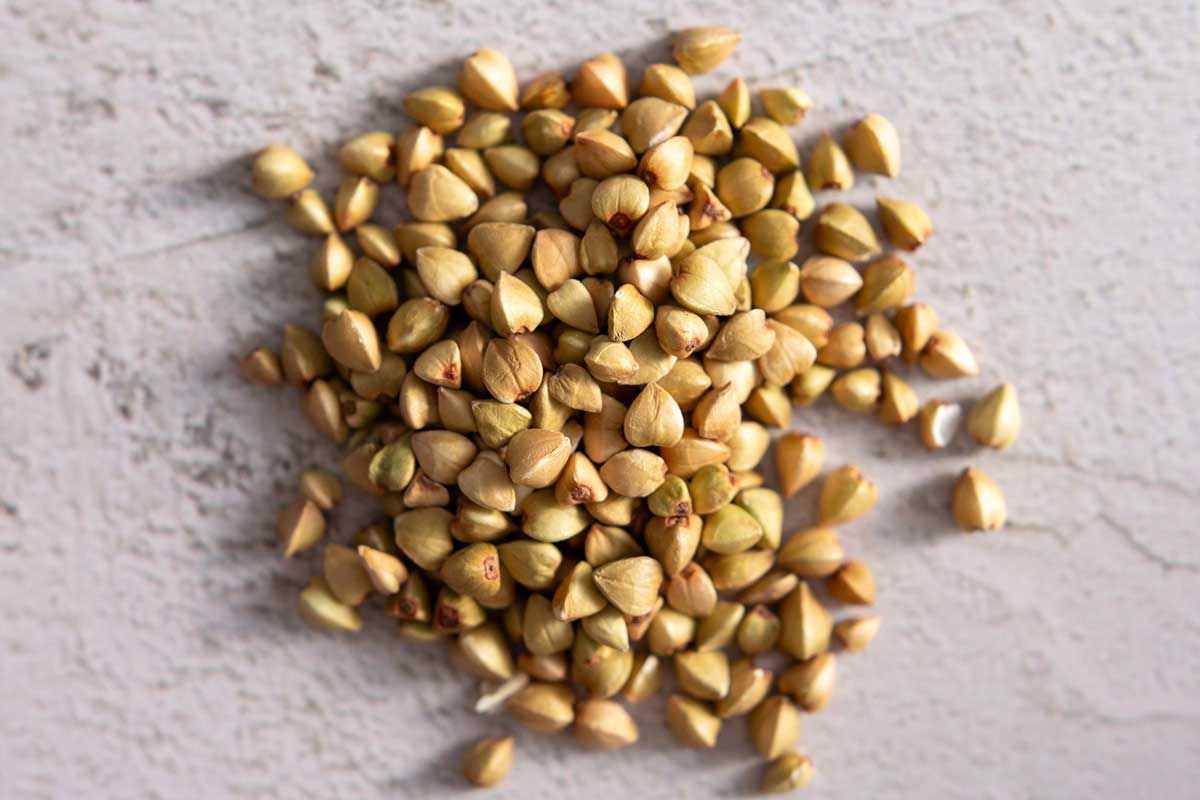
- Buckwheat is highly nutritious, offering a source of fiber and essential minerals, especially magnesium. It’s also packed with antioxidants, particularly rutin, which supports blood vessel health. Despite its name, buckwheat is naturally gluten-free, making it suitable for those with gluten intolerance or celiac disease.
- Buckwheat’s low to medium glycemic index makes it a good choice for those managing blood sugar levels. Plus, its high fiber content aids in digestion.
- Like amaranth or quinoa, these whole grain groats can be cooked like rice or oats, making them a fantastic ingredient for various dishes. From traditional porridge and pilafs to modern salads and even as a rice substitute, buckwheat is incredibly adaptable. It’s also used in making buckwheat flour, a popular alternative for gluten-free baking. We use buckwheat flour to make these High-Protein Buckwheat Pancakes with Blueberry Syrup, and they’re so fluffy and delicious!
Step-by-Step Instructions
Rinse the hulled buckwheat kernels under cold water until clear. After rinsing, soak 17.5 oz (2.6 cups or 500g) of buckwheat in cold water in a large bowl, fully submerged, and cover with a clean cloth for 6 to 7 hours.
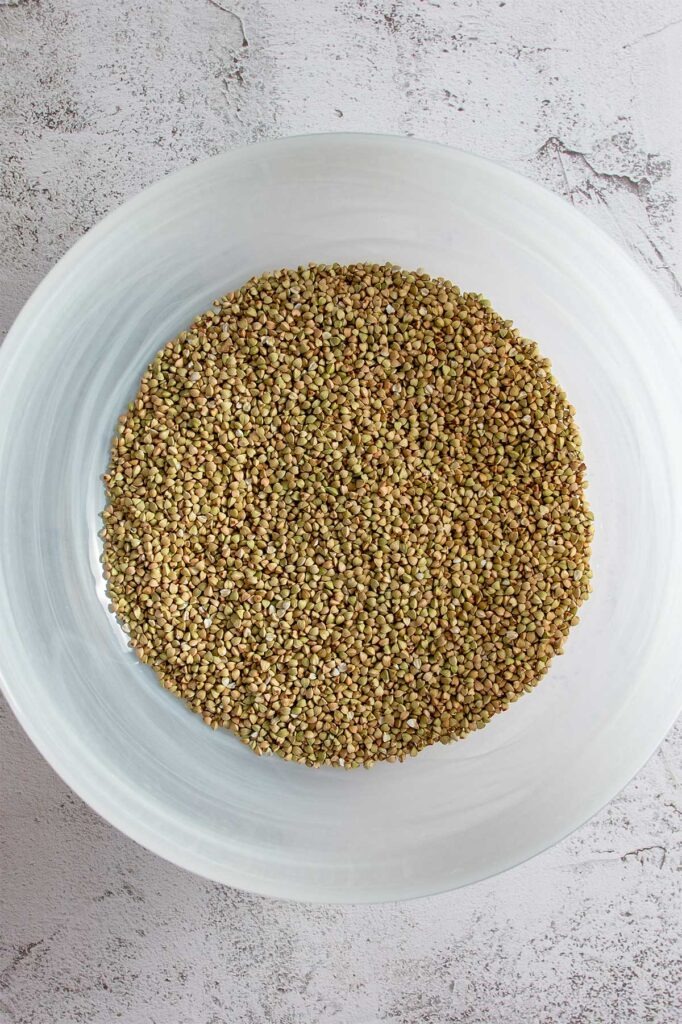

Once soaked, drain the remaining water, but do not rinse.


Transfer to a blender with 6.8 fl oz (0.9 cups or 200 ml) of water and ¼ tsp salt. Blend, starting at low speed and slowly increasing, until you get a very smooth texture without any pieces left. Pour the blended buckwheat mixture back into the bowl.
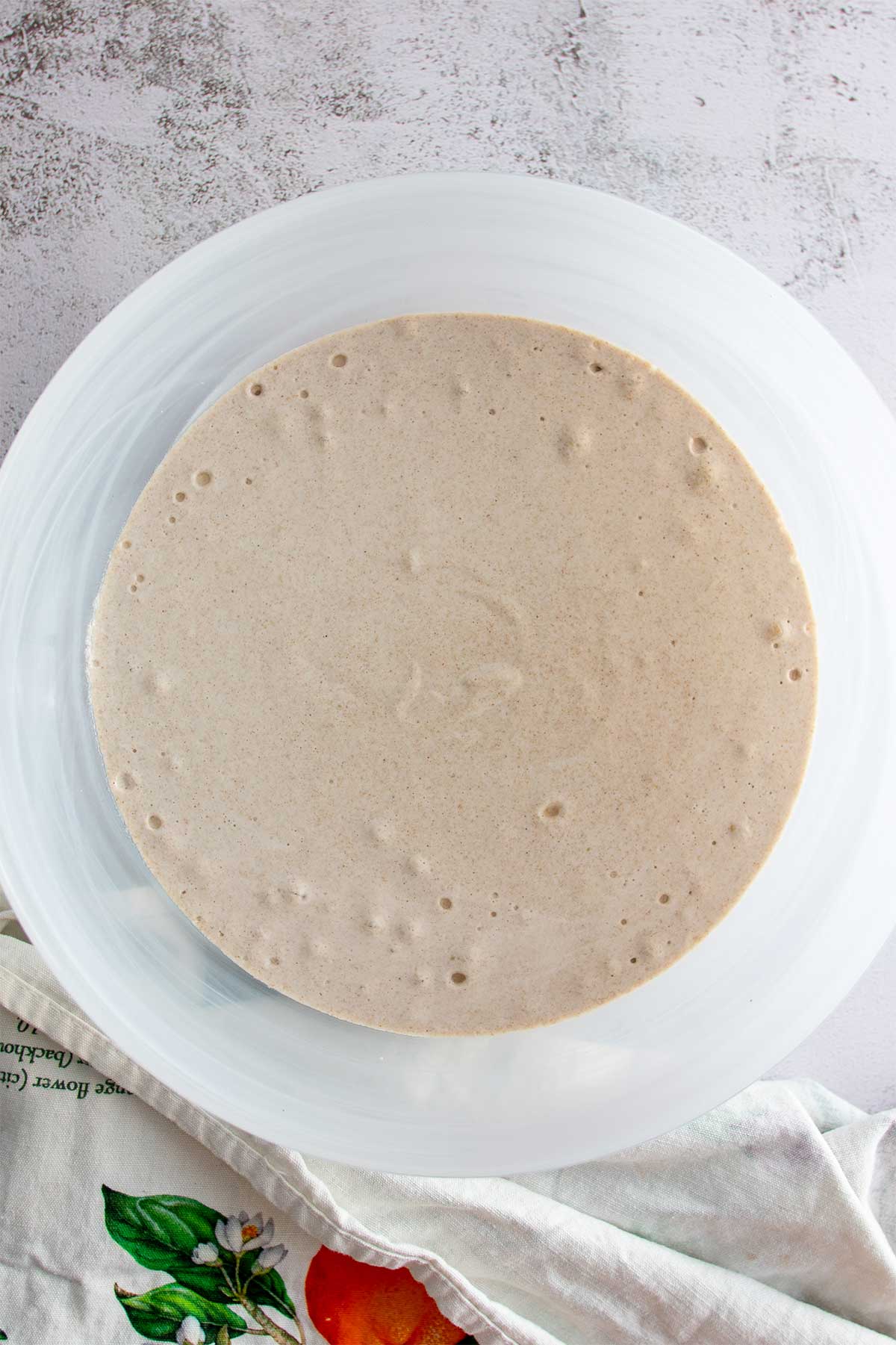
Cover it again and let it sit at room temperature for 12 to 24 hours to ferment. Please check the fermentation table below to confirm the time required based on your current climate.
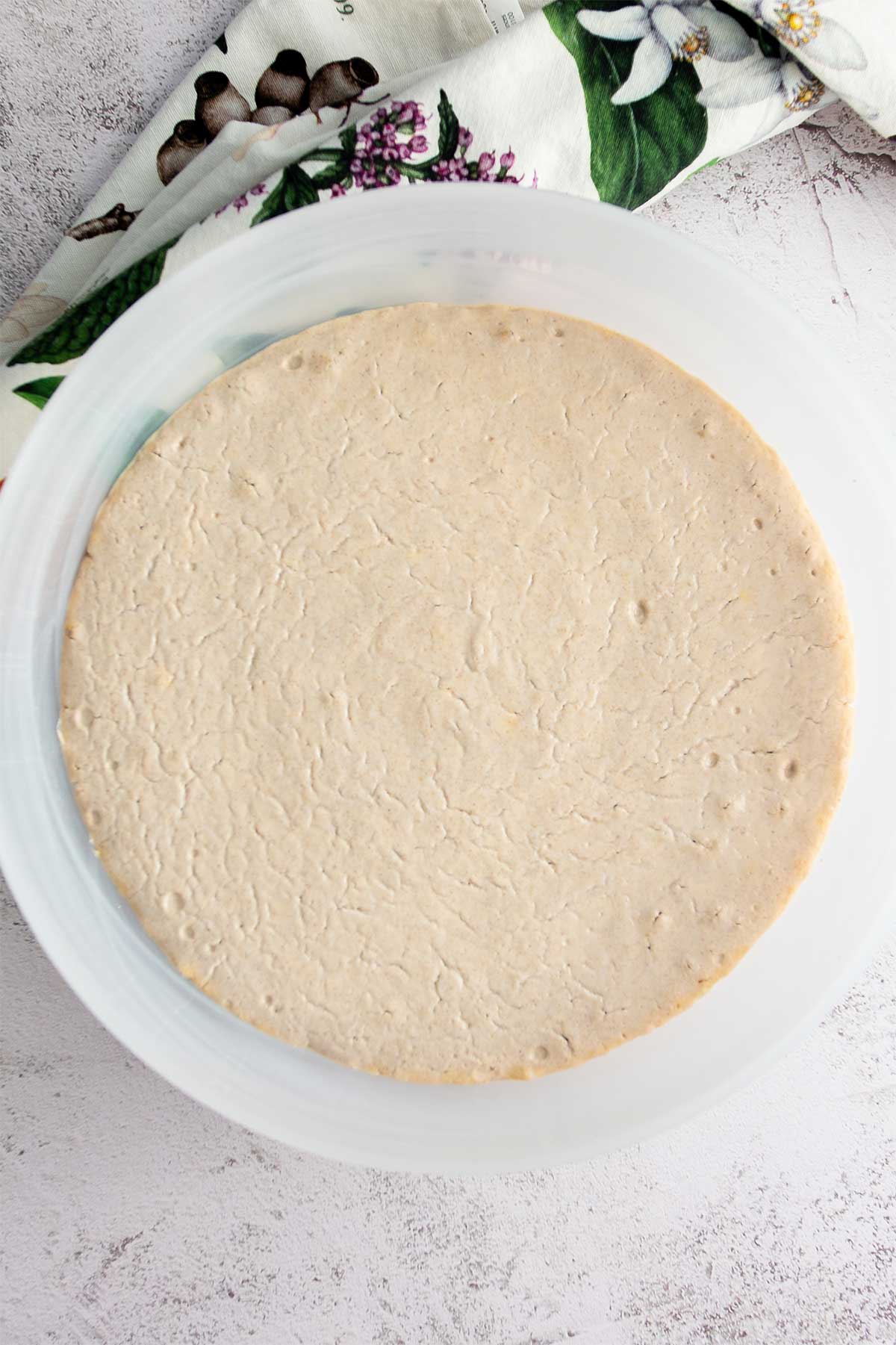

When you’re ready to bake, preheat your oven to 350°F. Line a loaf pan with baking paper and pour the fermented buckwheat dough into the pan. If you’d like, sprinkle the top with 2 tsp of poppy and sesame seeds (or whichever toppings you’d like).


Bake the bread in the preheated oven for 90 minutes. The bread should be golden brown and firm to the touch.


Allow the bread to cool down before slicing. This makes it easier to cut and improves the texture. Enjoy your homemade, nourishing, gluten-free buckwheat bread!


How Long to Ferment Your Buckwheat Bread Based on Your Current Climate
🌨️ Colder (Winter)
Indoor temperature range: ~70°F (20°C)
Soak: 6–7 hours
Fermentation time: Up to 24 hours
Note: If the temperature is lower than 70°F (20°C), place the bread in a warm spot or near a gentle heat source to help it ferment.
☀️ Warm (Summer)
Indoor temperature range: 75–85°F (25–30°C)
Soak: 6–7 hours
Fermentation time: Around 12 hours
Note: A warm environment speeds up fermentation, so check the texture after 10–12 hours.
🔥 Very Hot
Indoor temperature range: Above 85°F (30°C)
Soak: 6 hours
Fermentation time: As little as 6 hours
Note: The hotter it is, the less time needed. In extreme heat, soak the buckwheat in the fridge for 6 hours only.

1-Ingredient Buckwheat Bread (Nourishing and GF)
Equipment
Ingredients
- 17.6 oz (500 g) hulled buckwheat kernels (2.6 cups) - MUST be hulled, raw buckwheat kernels/groats for this recipe to work
- 6.8 fl oz (200 ml) water (0.9 cups)
- ¼ tsp (1.5 g) sea salt flakes
- 2 tsp (4 g) poppy and sesame seeds - optional
Instructions
- Rinse the hulled raw buckwheat kernels under cold water until the water runs clear. This ensures that any dust or impurities are removed.
- Transfer the rinsed buckwheat to a large bowl. Cover the kernels with a large volume of cold water, ensuring they are fully submerged. Cover the bowl with a clean cloth and let it sit for 6 to 7 hours.
- Once soaked, drain the water, but do not rinse the buckwheat kernels. Transfer them to a blender with 6.8 fl oz (0.9 cups/200 ml) water and the salt. Blend, starting at low speed and slowly increasing until you get a very smooth texture without any bits and pieces of buckwheat remaining.
- Pour the blended buckwheat batter back into the bowl. Cover it again and let it sit at room temperature for 12 to 24 hours (please see notes to determine how long you should leave it to ferment based on your climate). Once fermented, you will notice a very slight rise, and the mixture should be slightly bubbly inside.
- When you're ready to bake, preheat your oven to 350 °F. While the oven is heating, prepare a loaf pan by lining it with baking paper.
- Pour the fermented buckwheat dough into the prepared loaf pan. If using, sprinkle the top with poppy and sesame seeds.
- Bake the bread in the preheated oven for 90 minutes.
- Remove the bread from the loaf pan and let it cool completely before slicing. This is important to get the best texture. Now, enjoy your homemade, healthy buckwheat bread!
Video
FAQ
This depends on your location and current temperature, as fermentation is temperature-dependent. Colder climates will need a longer fermentation, and it can be shortened as the temperatures rise during the year, as the heat accelerates fermentation.
For colder climates (winter, with an indoor temperature of approximately 70°F (20°C)), ferment for 24 hours. If your indoor temperature is below 70°F (20°C), you can try leaving the batter in the warmest place in your house to give it the best chance of fermenting.
For warmer climates (summer with an indoor temperature between 75 – 85°F (25 – 30°C), I’d recommend starting with 12 hours of fermentation. We have tested this recipe in both summer and winter in Sydney Australia, which remains a pretty temperate climate. Depending on where you are in the world there might be a little bit of experimenting to figure out the perfect timing, but I promise it’s well worth it!
Some people from our IG community in more exotic locations with hotter and more humid climates have reported good results with as little as 6 hours of fermentation. If this is the case for you, start with 6 hours of fermentation and monitor the dough to avoid over-fermenting. The dough will have a slightly raised appearance and be a little bubbly inside when ready to eat.
Yes, fermentation does have a specific smell, which will be reduced when baking. Over soaking the buckwhat will result in a unpleasant smell, so keep it to 6-7 hours soaking time on the kitchen counter or in the fridge for extremely hot and humid climate.
Yes, it’s completely gluten-free.
This recipe only works with HULLED, NON-ROASTED buckwheat groats.
Unfortunately, it won’t work for this recipe.
It stays fresh for up to 3 days in a sealed container or wrapped in a kitchen cloth. I like to slice half straight away and freeze it to make the most of it.
Yes, slice and freeze for up to a month.
While the base recipe only requires one ingredient and cannot be swapped, you can certainly add other ingredients to customize the bread to your liking. Consider adding seeds, nuts, dried fruits such as dates, or spices for additional flavor and texture. I love a mix of black olives (pitted!), rosemary, and walnuts! Just remember to add these extras after the fermentation process and before baking. I however recommend tasting the bread without any ad-ons first, to make sure you have the perfect fermentation time, and know what to expect in terms of taste and consistency. Then, feel free to experiment with these additional ingredients to achieve your desired balance of flavor and texture.
You can; it will still work, but I find it provides a much-needed touch to the flavor of the bread.
It has a very slight rise – it’s quite different from yeast fermentation. Don’t worry if it looks like your dough hasn’t risen much – it will still work.
If that’s the case, I would recommend rinsing the buckwheat as it might develop a bit of a smell otherwise. It’s still fine to consume. We recommend not to rinse in our recipe, as when we tested it, we got a slightly nicer texture once baked, but it still worked when rinsed.
They are fine to leave on the counter. However, if it’s too hot or humid where you are, you can place them in the fridge. Leave out of the fridge for the fermentation part.
If you slice it before it cools down, it will just have a mushier texture.
If your indoor temperature is lower than the one we have mentioned, it might need to be fermented longer. Use filtered water if the water in your area contains a lot of chlorine, as this will negatively impact fermentation. Someone in the community also mentioned fermenting the dough directly in the loaf pan as a tip to get it to rise even more.


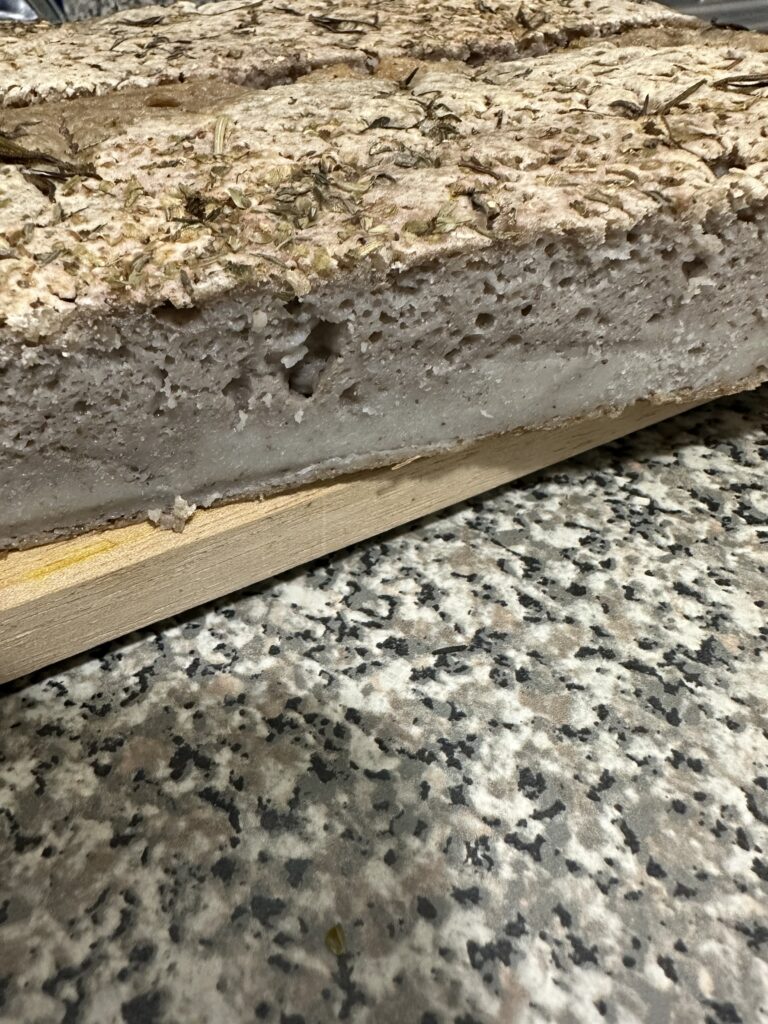
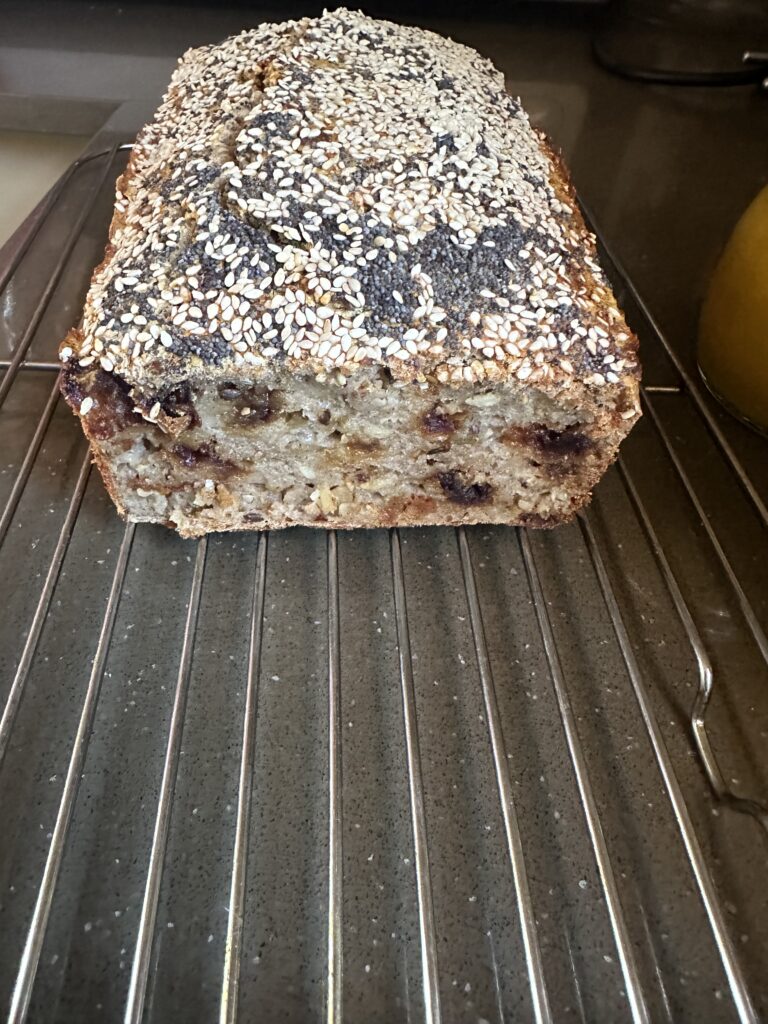








What a wonderfully clever and simple, wholesome recipe! I baked my loaf yesterday and everything went really well and I absolutely love the bread. I am in Western Australia and we are in the middle of summer here so it’s very warm, which made the fermenting easy, I did it overnight for about 12 hours. Delicious and so easy to make. I never would have thought of doing this on my own – thank you so much!! 😊
So happy you loved it Emma 💚
So happy you loved it Emma! Thanks for sharing your tips for Western Australia timing 💚
Thanks for the recipe. In tropical humid weather, it took 7 houts to ferment. Worked great however I’m having trouble toasting it. The edges start getting burnt before the bread toasts. Are people using regular toasters? Any tips would be appreciated.
Hi Kim, so happy you’re enjoying the bread, I personally toast it in the air fryer and it works perfectly, but maybe someone else will have some tips about using a toaster 🙂
Oh, how we LOVE this bread so much! I can’t thank you enough for this recipe. It’s a definite favorite in our house. We love it toasted with all kinds of things like avocado, tuna, eggs, etc. we kust adore it and it’s so good for us! It’s chilly here in the US so today, it’s been in my oven fermenting all day with the light on. I just peeked at it and it’s ready to go! Thank you again for such a fantastic bread recipe!
I’m so happy you love it so much Tricia, thank you for your review 💚
I just made this and fermenters for 17 hrs. It’s winter here and furnace is on so it’s 20-22 degrees. The “ bread” was dense and gummy inside with a very tough exterior. Not sure what went wrong. It also seemed smaller than when I put it in the oven. Too was lightly brown and cracked when I took it out. What went wrong?
Hey Melissa, sorry to hear you had trouble with the recipe, it sounds like the fermentation did not happen. I would recommend fermenting it for the full 24 hours and perhaps closer to a source of heat 🙂
Same with mine. I fermented it 18 hours but I don’t think it was enough. Hard and shiny on the outside and gummy in the middle. I will try the full 24 hours. How do you know when it’s fermented?
Hello! I wanted to ask if I can use sprouted groats in this recipe?
I have not tried, I think you could get away with substituting a little bit for sprouted but probably not the full recipe. I would recommend giving it a go as is first to master the fermentation time before playing around with it 🙂
This recipe has been such a gift to my family! I recently made it with olive oil on the bottom of the pan before adding the fermented dough/batter, then added more olive oil on top with dried rosemary and flaky sea salt, like focaccia, and it was DELICIOUS! We then slice the bread thinly and toast it. Thank you for this recipe!
That makes me so happy Amanda, your additions sound SO GOOD! I’m trying them next time I make it 😍
Can I use this recipe in a bread machine?
I’ve never used a bread machine, so I’m not sure but hopefully someone else will know 🙂
Absolutely amazing, fermentation worked, added some fennel seeds, too.
Will experiment more with flavors in the next one.
I’m so happy you loved it Kerstin! Fennel seeds sounds delicious, let us know what else you try 💚
This was absolutely delicious and tastes like a whole grain European bread. I sliced the loaf into around 12 slices and froze each between parchment paper. It freezes so nicely, and I put it in the microwave for 30-60 seconds and then double toast it and add a dollop of peanut butter. Thank you!
Hey Heidi, I’m so happy you enjoyed the bread! Great tip to defrost it in the microwave first 💚
Good gf bread! Instructions were perfect and since this was my first batch I did one side of topping with everything bagel seasoning and the other with what it called for plus sunflower seeds (because I like a little more crunch on my bread) and it was delicious.
A slice was lighter than expected. Alone it’s very plain but I topped mine with peanut butter and fig jam but looking forward to another version with more add-ins on the next one. Thanks for sharing this recipe!
Hey Gina, I’m so happy you enjoyed it! Fig jam and peanut butter combo sounds so good, I’m going to try it 😍
Absolutely delicious!!! How did we not know this recipe sooner! 😁
Thank you, Sarah! I followed the recipe to the letter and it turned out amazing, as all your recipes do as a matter of fact! 🙏🏻
That makes me so happy, thanks Miruna 💚
I gave this 5 stars because I love the homemade and cheaper option to buckwheat bread. The first time or two it was perfect and the last few batches are gummy and dense in the middle. I don’t get the “crumb” like you show in the image. I follow the recipe and leave it to ferment in my turned off oven to stay at a room temp. Any tips or help on this? Thank you!
I’m very happy to hear you got good results at first! Has something changed since then? Did you make them in summer when you were successful and are now in winter?
Mystery solved! Let the groats strain fully to remove all the liquid (while the “slime” sticks). Previously, I would strain , shake, and blend likely putting too much liquid back in the blender.
Today, I let them sit in a sieve while I did a load of dishes then proceeded to blend. This resulted in the perfect bread🩵
Hi Sarah thank you for this recipe. I live in quite a hot climate and I left my batter to ferment a bit too long and it really stinks! Is it still ok to use?
Oh no, if it smells fishy, then the batter is off, how long did you ferment it for? I would also recommend letting it soak in the fridge if it’s extra hot at the moment!
Same here! it sticked like rotten eggs. still baked it in the oven, but then I decided to throw it away. Wasn’t sure how it was supposed to smell…. I soaked the buckwheat maybe too long (more than 10 hours) and I fermented it for 24 hours. Living in a warm climate (29-30 celsius). Going to try again!
Hi Libro, it does sound like it was over-fermented. For a warm climate like yours, I recommend sticking to the 6 hours of soaking for the buckwheat (preferably in the fridge), and 12 hours of fermentation is probably a great place to start! Let me know how you go next time 🙂
I will try that, many thanks for the advice!!
You’re most welcome 💚 let me know how you go 🙂
After my first attempt at making this bread, I will say I love the flavor and that it’s amazing that this recipe only has one ingredient plus a little salt. I followed the directions very precisely and all the steps were just as expected. My loaf was a little underdone after cooling completely. But I will try again after checking the accuracy of my oven temperature. Thank you for a lovely recipe.
So happy you liked it Jennifer! Let us know how you go next time 💚
I have made this bread several more times very successfully. We love it! My oven was the problem the first time, when I got the less than perfect result ( It was reading 350° F when it was only at 300 for part of the time!) Thank you so much for the recipe! I’ve shared it several times with others.
Thank you for sharing your tips Jennifer! I’m so happy you’re enjoying the recipe 💚
Unfortunately it did not work for me. I followed steps, used filtered water. Left to ferment at room temperature for 24h. Baked as indicated.
Texture was dense, like compacted raw dough. 😢
Hi Chris! Sorry to hear that, it sounds like fermentation did not happen, it might have been too cold! If you want to give it another go, I’d recommend leaving it near a source of heat, or in the oven with just the light on 🙂
Thank you, Sarah, for sharing such an amazing, delicious, and absolutely perfect recipe! It truly is the best homemade bread I’ve ever had. While experimenting with your basic recipe, I tried adding baking soda and olive oil at the end, after fermentation, to enhance the bread’s fluffiness and flavor — and it turned out incredibly yummy. I’m so grateful for this fantastic recipe — thank you again!
Thank you so much for your lovely words Olga, I’m so happy you loved the bread! And thanks for sharing your tips, I’ll have to give it a go, sounds delicious x
This was absolutely delicious, thank you!
Thanks Maria, so happy you like it 🥰
I bought buckwheat just to try out this recipe because it just seemed too incredible and it kinda is… my blender took a long time to do its work and it wasn’t entirely the same as the picture (there were visible bits) but I touched it and the texture was fairly smooth and so I just let it ferment. My blender is the attachment for a stand mixer so probably not powerful enough. I live almost along the equator (Singapore!) and I let it ferment for about 14 hours (coz I had to go to bed) and I could smell it when I walked into the kitchen this morning. The duration of the bake seemed really long but… it worked. I just had my first taste of the bread end, toasted and slathered with butter and it was tasty! Chewy and crusty, qualities of fine bread and I liked the distinct taste too. Definitely will try this again with a shorter ferment time to see if there’s any change in the taste.
Hey Min, thanks for sharing your experience, I’m so happy you’re enjoying the bread! Some people in very hot location have reported good results with fermenting as little as 6 hours, let us know how you go next time 😍
Followed instructions exactly and nothing like the images shown appeared. Had to use 3X water and still had to remove the batter by hand it was so thick and it did not appear to ferment after 24 hours. Very disappointed in this .
Hi Mikee, I’m sorry you didn’t get good results! From what you are describing, the wrong kind of buckwheat was used. This recipe will only work with raw (green) hulled buckwheat. Roasted (even slightly) or hulled, retain too much water, and won’t ferment or cook properly. Hope you give it another go, it’s been a game changer for us 💚
Cooked this for the first time today after recently going gluten free and stumbling across this recipe. I fermented it for 20hrs in a NZ spring climate. It would have been helpful to know what function you used on the oven but I worked it out. It turned out PERFECT first go (so pleased), hard crust and moist yet firm interior, very bread like. Tastes great too, very happy I tried this and thanks so much for the amazing recipe!
Hey Jasmine, I’m so happy you’re loving the bread 💕
This worked reasonably well, I like the taste and texture (I had to ferment in my proving drawer as my house is only around 17c. However my grease proof paper liners wouldn’t come away from the loaves and I ended up having to cut them away. Maybe because I chose to ferment in the loaf tins for the final few hours. What loaf tin liners do you recommend? (UK)
Hey Jane, I’m glad you like the bread! I have not had this issue even when fermenting in the loaf pan, I’m in Australia, but hopefully someone else in the community from UK can help with brand recommendation 🙂
You can wet the paper liner with water and crumple it nicely before putting in the loaf pan. This gives the right shape to the dough as well as prevent it from sticking on the bread.